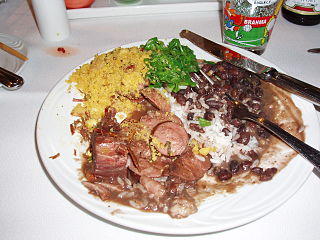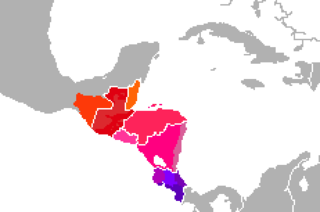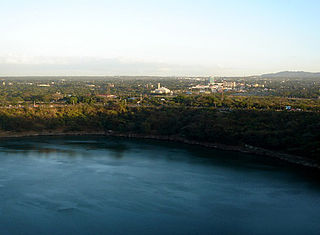
An enchilada is a corn tortilla rolled around a filling and covered with a chili pepper sauce. Enchiladas can be filled with a variety of ingredients, including various meats, cheese, beans, potatoes, vegetables or combinations. Originating in Mexico, enchiladas are a popular dish throughout Mexico and the American Southwest.

Managua is the capital and largest city of Nicaragua, and the center of an eponymous department. Located on the southwestern shore of Lake Managua, it had an estimated population 1,042,641 in 2016 within the city's administrative limits and a population of 1,401,687 in the metropolitan area, which additionally includes the municipalities of Ciudad Sandino, El Crucero, Nindirí, Ticuantepe and Tipitapa.

Ceviche, also cebiche, seviche or sebiche, is a seafood dish typically made from fresh raw fish cured in citrus juices, such as lemon or lime, and spiced with ají, chili peppers or other seasonings including chopped onions, salt, and cilantro. Because the dish is not cooked with heat, it must be prepared and consumed fresh to minimize the risk of food poisoning. Ceviche is usually accompanied by side dishes that complement its flavors, such as sweet potato, lettuce, corn, avocado or plantain. The dish is popular in the Pacific coastal regions of Latin America. Though the origin of ceviche is hotly debated, in Peru it is considered a national dish.

A gringo (male) or gringa (female) is someone considered a foreigner from the perspective of Spanish and Portuguese-speaking countries in Latin America. In Spanish and English, gringo usually refers to an English-speaking male foreigner, especially one from the United States. In English it often carries a derogatory connotation, and occasionally does so in Spanish. Possible other connotations may include monolingualism, a lack of understanding of Hispanic culture, and blond hair. The word was originally used in Spain to denote any foreign, non-native speakers of Spanish.

Llanito or Yanito is a form of Spanish heavily laced with words from English and other languages, such as Ligurian; it is spoken in the British overseas territory of Gibraltar. It is commonly marked by a great deal of code switching between Andalusian Spanish and British English and by the use of Anglicisms and loanwords from other Mediterranean languages and dialects.

Latin American cuisine is the typical foods, beverages, and cooking styles common to many of the countries and cultures in Latin America. Latin America is a highly diverse area of land that holds various cuisines that vary from nation to nation. Some items typical of Latin American cuisine include maize-based dishes arepas, pupusas, tacos, tamales, tortillas and various salsas and other condiments. These spices are generally what give the Latin American cuisines a distinct flavor; yet, each country of Latin America tends to use a different spice and those that share spices tend to use them at different quantities. Thus, this leads for a variety across the land. Sofrito, a culinary term that originally referred to a specific combination of sautéed or braised aromatics, exists in Latin American cuisine. It refers to a sauce of tomatoes, roasted bell peppers, garlic, onions and herbs.

Augusto C. Sandino International Airport or ACS is the main joint civil-military public international airport in Managua, Nicaragua named after Nicaraguan revolutionary Augusto Nicolás Sandino and located in the City's 6th ward, known locally as Distrito 6. Originally christened as Las Mercedes Airport in 1968, it was later renamed Augusto C. Sandino International Airport during the Sandinista government in the 1980s and again in 2001 to Managua International Airport by then-president Arnoldo Alemán. Its name was changed once more in February 2007 to its current name by President Daniel Ortega to honor the revolutionary. Managua also has an alternative landing strip at Punta Huete Airport. Punta Huete was designed for larger aircraft. This alternative landing site, however, does not service commercial aircraft. The airport is managed by the state-run Administrative Company of International Airports, more commonly known as the EAAI given its Spanish name, the Empresa Administradora de Aeropuertos Internacionales.

The city of Jinotega is the capital of the department of Jinotega in the north central region of Nicaragua.

Masaya is a caldera located in Masaya, Nicaragua, 20 km south of the capital Managua. It is Nicaragua's first and largest national park, and one of 78 protected areas of Nicaragua. The complex volcano is composed of a nested set of calderas and craters, the largest of which is Las Sierras shield volcano and caldera. Within this caldera lies a sub-vent, which is Masaya Volcano sensu stricto. The vent is a shield type composing of basaltic lavas and tephras and includes a summit crater. This hosts Masaya caldera, formed 2,500 years ago by an 8-km³ basaltic ignimbrite eruption. Inside this caldera a new basaltic complex has grown from eruptions mainly on a semi-circular set of vents that include the Masaya and Nindiri cones. The latter host the pit craters of Masaya, Santiago, Nindiri and San Pedro. Observations in the walls of the pit craters indicate that there have been several episodes of cone and pit crater formation.

Nicaraguans are people inhabiting in, originating or having significant heritage from Nicaragua. Most Nicaraguans live in Nicaragua, although there is also a significant Nicaraguan diaspora, particularly in Costa Rica and the United States with smaller communities in other countries around the world. There are also people living in Nicaragua who are not Nicaraguans because they were not born or raised in Nicaragua nor have they gained citizenship.

Nicaragüense de Aviación (NICA) was a commercial airline based in Nicaragua. Its service hub was the Augusto C. Sandino International Airport, previously known as the Managua International Airport.

Nicaraguan cuisine includes a mixture of indigenous Native American cuisine, Spanish cuisine, and Creole cuisine. Despite the blending and incorporation of pre-Columbian and Spanish-influenced cuisine, traditional cuisine differs on the Pacific coast from the Caribbean coast. While the Pacific coast's main staple revolves around beef, poultry, local fruits, and corn, the Caribbean coast's cuisine makes use of seafood and coconut.

Central American Spanish is the general name of the Spanish language dialects spoken in Central America. More precisely, the term refers to the Spanish language as spoken in Costa Rica, El Salvador, Guatemala, Honduras, and Nicaragua. Although Panama is part of Central America, Panamanian Spanish is classified as a variety of Caribbean Spanish.

Tourism in Nicaragua has grown considerably recently, and it is now the second largest industry in the nation. Nicaraguan President Daniel Ortega has stated his intention to use tourism to combat poverty throughout the country.

Tiscapa Lagoon is a lagoon of volcanic origin that formed over 10,000 years ago. It is located in the capital city of Managua in Nicaragua, and covers an area of 0.13 km2. Tiscapa Lagoon was protected as a natural reserve on October 31, 1991. The reserve is managed by the Ministry of the Environment and Natural Resources (MARENA) and comprises one of the 78 protected areas of Nicaragua.

The following outline is provided as an overview of and topical guide to Nicaragua:




















